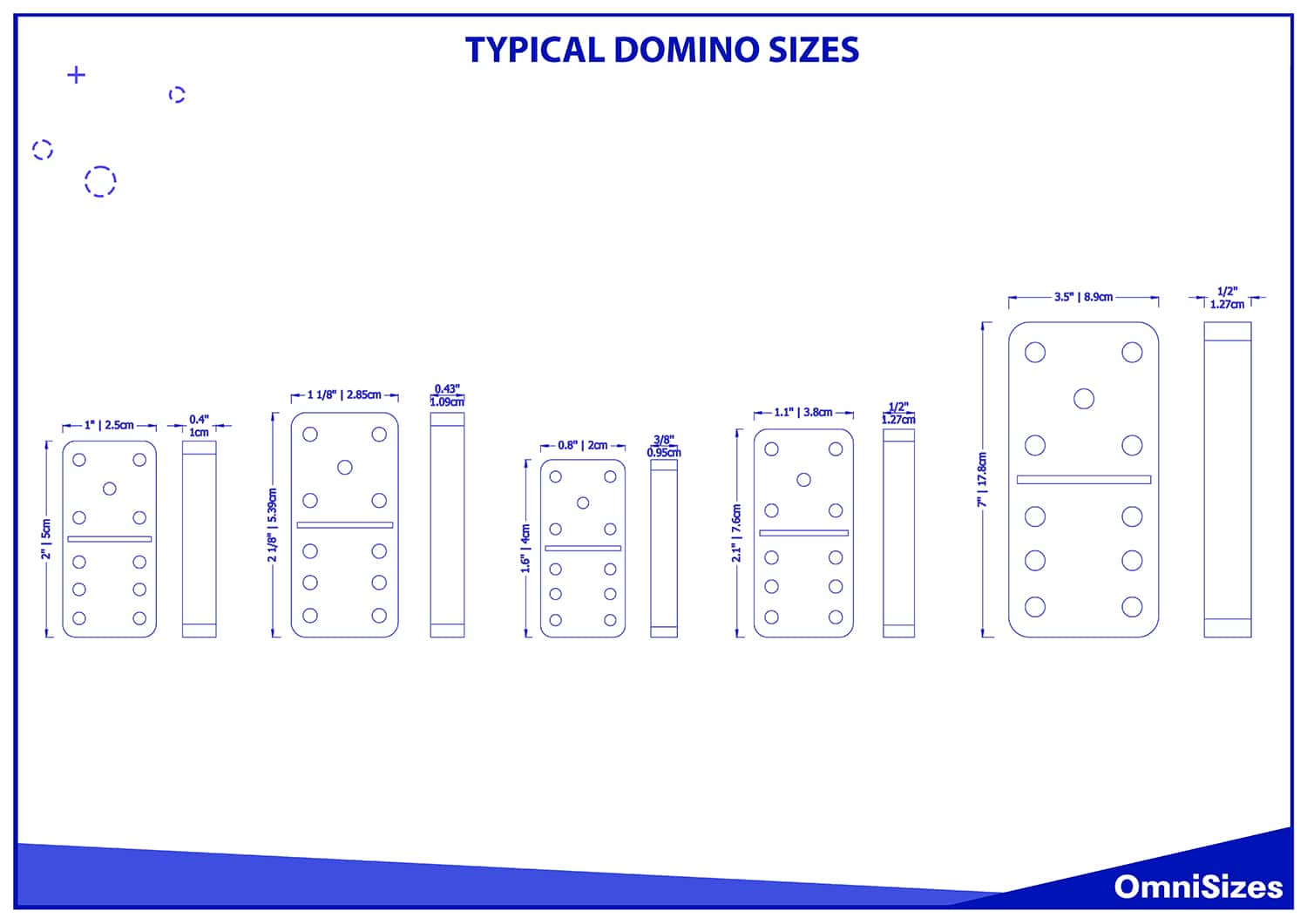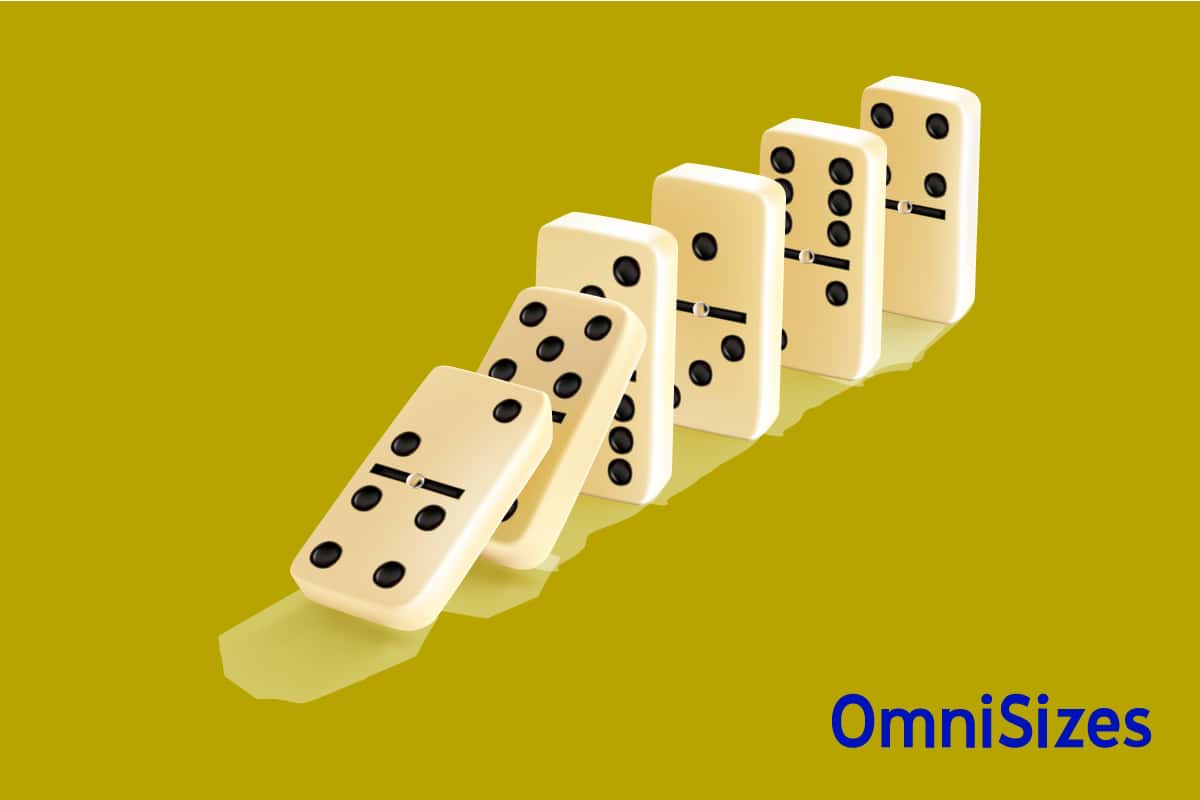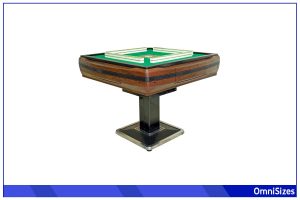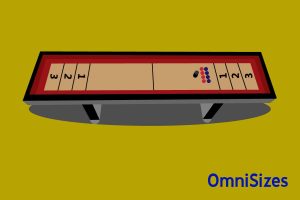Dominoes is cherished for its simplicity and the strategic depth it offers. Domino sizes affect everything from the ease of handling the pieces to visibility. With their distinct rectangular shapes, dominoes have been a primary part in family game nights, competitive tournaments, and even large-scale artistic installations.
A standard domino tile is 1 × 2 inches (2.5 × 5 cm) and 0.4 inches thick (1 cm). Size variants range from miniature, at 0.8 × 1.6 inches (2 × 4 cm), and outdoor sizes up to 3.5 × 7 inches (8.9 × 17.8 cm).

This guide will briefly cover the rules of playing dominoes, as well as elaborate on the dimensions of domino tiles.
How to Play Dominoes
Dominoes is a game played with a set of rectangular tiles known as dominoes, each divided by a line and marked with a number of spots, or ‘pips’, on each side. The goal varies by game type but generally involves matching the numbers on the tiles or achieving a certain score. This versatile game can be enjoyed by two or more players and offers various versions to play.
Setting Up the Game
To begin, shuffle the dominoes face down, and each player draws a set number, usually seven, for a two-player game. The remaining pieces form the ‘boneyard’ and are used as the draw pile throughout the game. The heaviest tile, which is the tile with the most pips, goes first.
Basic Rules
Players take turns laying down tiles from their hands to the game table, matching one end of the domino to a part of another domino with the same number of pips. Play continues until one player has emptied their hand or no more moves are possible. If a player cannot make a move, they must draw from the boneyard.
Scoring
In most domino games, the winner is determined by the lowest number of pips left or the first to reach a predetermined score over several rounds. Points may be scored during the game by making the ends of the domino chain add up to a multiple of five or three, depending on the game variant.
Standard Domino Sizes
Dominoes are a set of pieces, commonly referred to as tiles or bones, used to play a range of games. Standard domino sizes provide a uniform system for fair play and easy handling.
Dimensions of Standard Dominoes
The most commonly used size for domino tiles is the standard size which measures approximately 1 × 2 inches (2.5 × 5 cm). This size strikes a balance between being large enough to handle comfortably and small enough to be portable. Standard dominoes are usually about 0.4 inches (1 cm) thick, so they can stand on edge without toppling over easily.
Double-Six Set
The Double-Six set is the most popular set for traditional domino games, consisting of 28 tiles. Each tile has a combination of pips ranging from 0 (blank) to 6. The size of these dominoes falls into the standard category, making them ideal for family games and recreational play.
Double-Nine and Larger Sets
Double-Nine sets include 55 tiles and provide more playing options and complexity, suitable for games like Mexican Train. Larger sets, such as Double-Fifteen, expand the possibilities further and typically use standard-size tiles to maintain consistency in play.
Domino Size Variations
Dominoes come in a range of sizes, from miniature sets that are easy to transport to jumbo dominoes that make a visual impact.
Miniature Dominoes
Miniature dominoes, measuring around 0.8 × 1.6 inches (2 × 4 centimeters) and ⅜ inches thick (0.375 cm), are compact and perfect for travel. These smaller sets often appeal to those with limited space or who enjoy games on the go.
Jumbo Dominoes
Jumbo dominoes are larger, typically 1.1 × 2.1 inches (3.8 × 7.6 centimeters) and 0.5 inches thick (1.27 cm), making them easier to handle for those with dexterity issues or for children just learning the game. Their size makes them stand out, suitable for more visual play and for those who enjoy a more tactile experience.
Giant Outdoor Dominoes
For outdoor fun, giant dominoes can go up to 3.5 × 7 inches (8.9 × 17.8 centimeters) and 0.5 inches thick (1.27 cm). These are designed for garden games, social events, and can even serve as decorative pieces. Made of durable materials, they can withstand the elements and provide a larger-than-life gaming experience.
Domino Tiles vs. Cards
While heavy plastic and wooden dominoes are traditional, you can also find packs of Double-Six Dominoes made from cardboard. These are usually referred to as ‘cards’ and are used identically to their tile counterparts.
Durability Issues
Domino cards have the same face dimensions as traditional domino tiles (roughly 1 × 2 inches), but they are considerably thinner (around 1/8 of an inch). They are also prone to warping during play, especially if the players aren’t careful when handling the cards.
Luckily, domino cards are a lot more affordable than traditional domino sets. So, while a set may not last for longer than a nighttime of play, you can pick up extra sets for dirt cheap.
‘Slapping’ Sounds
One of the most satisfying things about playing with domino cards is the noise they make when slapped on a flat surface. This is usually done by slapping the card face up on the table with a quick flick of the wrist.
When done correctly, it will produce a satisfying slapping sound while also laying flat on top of another card in play. Doing this with plastic or wooden dominoes runs the risk of damaging the tile, making it easier for the players to identify the pips from visual cues.






